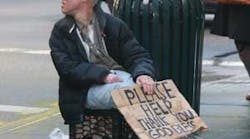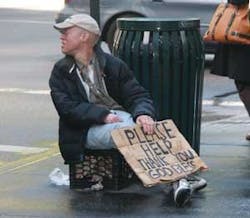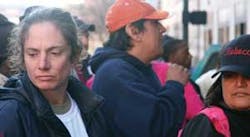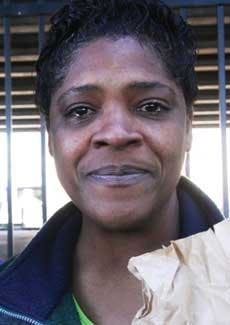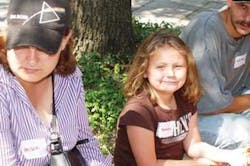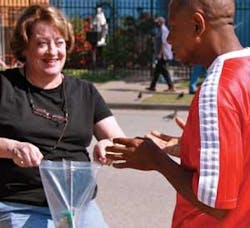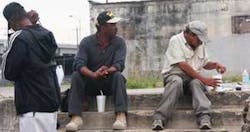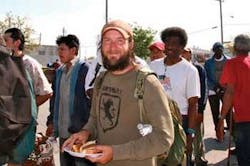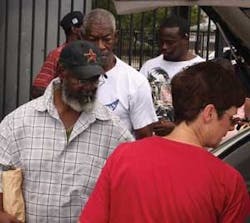An “invisible” man
It's a drizzly 41 degrees outside. Bone-chilling winds are gusting up to 28 miles per hour. That's winter in Houston, and I'm one of the lucky ones in the city. After eating a hot meal that includes some of my favorite dishes and spending time chatting with friends on my cell phone and computer, I'll drift off to sleep in a warm, dry house snuggled up in a pillow-top bed.
Undoubtedly, the majority of dental hygienists in this country spend their evenings in a very similar manner, but the evening's comforts are in stark contrast to what happened this morning. I spent the first half of the day achieving a goal that has eluded me for years. For the first time ever, we did not run out of hygiene kits for the homeless during our monthly distribution of Just Add Water kits.
The homeless situation around this country first got my attention 20 years ago. While visiting my family in Northern Virginia over the New Year's holiday, my mom and I made a trip into the city to visit the Vietnam War Memorial. The city was shrouded in a blanket of bitter cold. The steel gray sky kept the air damp and wind gusts tore through my flimsy south Texas-style winter clothing. It was my first visit to the Memorial, whose very existence underscores one of the most tragic and chaotic periods in our country's history.
The stark and somber nature of the monument, carefully placed on the nation's capital mall, was enough to contemplate, but seeing homeless men sleeping on subway grates in a feeble attempt to keep warm painted another dark canvas. Men, dressed in ragged clothes, sat around campfires. Flimsy camping tents dotted the frozen grass. I had come face to face with the homeless; a glimpse of a tragic human situation burned into my brain.
Taking a hot shower every day is a nonexistent luxury for those who are homeless. Basic hygiene tools like soap, shampoo, and a toothbrush are prized commodities. Most living on the streets carry their meager possessions in plastic grocery sacks, dirty, tattered backpacks, or worn-out canvas totes.
Caroline, a victim of domestic abuse
A decade ago I began traveling a lot. At first I loved getting all of those cute soaps and shampoos from various hotels, but the newness soon wore off and the sheer waste of using a dab of soap and throwing out the rest didn't make sense. Like most women, I prefer to use my own personal-care products.
My pack-rat nature, coupled with growing up in a poor family, made it hard to throw things out. The stockpile of hotel goodies started growing, sharing closet space with a grab bag full of toothbrushes and paste gathered from convention after convention. A notice in the church bulletin about the homeless caught my eye and a plan was born — clean out the closets and make basic hygiene kits.
Hotel toiletries, a toothbrush, and toothpaste fit neatly into a quart-size Ziploc® bag. Within a couple of years, the contents grew to include a washcloth, comb, tongue cleaner, xylitol mints, packs of single-dose antibiotic ointment, a razor, and five adhesive bandages housed in a larger, resealable bag — everything a person needed to get clean.
In the early years I donated two to three hygiene kits a month to the church, but the project took on a life of its own three years ago. One Sunday, Colette Potier, the observant co-chair of the Homeless Committee, spied me dropping off a grocery sack full of kits. She started asking me about the contents and I countered with questions about the need.
The conversation soon shifted to the Lemonade Run, the Homeless Committee's monthly outreach project where members distribute food, clothing, and personal hygiene items directly to homeless men, women, and children. On August 15, 2007, I went on my first Lemonade Run and distributed 75 hygiene kits. The kits were gone in less than 30 minutes. I was hooked.
The next step was figuring out how to get more supplies and raise money to purchase things that people need, but rarely get donated. Friends and professional colleagues who travel heard about the project, which I dubbed Just Add Water. I sent e-mails and posted to the AmyRDH.com e-mail list, complete with photos of men, women, and children living on the streets and started telling audiences about the plight of the homeless.
Boxes loaded with toiletries, washcloths, partially used bottles of shampoo, conditioner, lotion, and canvas convention bags started showing up on my doorstep. Many times, I had not personally met the donors, but they had heard about Just Add Water. Audience members would go out and buy supplies during lunch breaks. One time they cleaned out the Target across the parking lot, and I flew home with 180 washcloths. Friends who don't travel much sent checks. The combined donations were used to purchase empty 2 oz. bottles, deodorant, razors, combs, and antibiotic ointment.
What began as a casual commitment to helping make the planet a better place to live has taken on a life of its own. Two years ago, donations started coming in at a fast clip. When you're asking for help, it is critical to accommodate those willing to donate.
Surviving in a shelter — Hannah and her mom and dad
Three years ago, Discus Dental surprised the Just Add Water project with a huge donation of toothpaste, xylitol mints, and starter kits. Their generosity meant we had to get a small storage unit immediately. Then we'd be able to accept donations without worrying about where to store things. We were in business, and supplies started pouring in!
Anne passing out supplies
Individuals shipped cases of toilet paper. Tess Toothbrush Company supplied mismarked toothbrushes at cost. Colgate and Sunstar sent mismarked brushes, out of production inventory, and small tubes of toothpaste. Zirc donated hundreds of resealable bags. DentalEZ gave dozens of convention bags. The Orascoptic booth became the central drop-off donation spot for attendees at dozens of conventions around the country. 3M ESPE started supplying adhesive strips in giant rolls that we separated by hand into usable segments; the most recent shipment came in little sturdy plastic boxes like you see in the drug store. What a find! Once empty, the containers make perfect soap boxes.
Individual hygienists cleaned out their closets, donated toothpaste, brushes, personal-care items, and convention bags. Patients and coworkers began bringing bags of washcloths and hygiene items. My hairdresser of 38 years donates a gallon of shampoo every month, and my manicurist surprises me with bags of washcloths throughout the year. The mother of a very favorite patient rescued more than two gross of toothpaste and another gross of brushes that were going to be discarded. The school district where she works wouldn't store the supplies over the summer break, a bonus for the Just Add Water project. Members read the church bulletin and drop off sacks of toiletries, combs, and feminine hygiene supplies at the hospitality desk.
A few dollars can go a long way. The local dollar store sells a 20 pack of combs for $1.09. The Internet is a bulk-purchasing paradise. Recent purchases included 1,780 razors and 24 gross of single-dose antibiotic ointment packs at rates far below standard retail. Neither of those items weigh much, so shipping was nominal. Several years ago I found a company that specializes in hard-to-find products and doesn't charge shipping if the order is over $80. They have the best price on the travel-size Crystal Stick deodorant, which lasts about nine months with daily use and doesn't evaporate over time. We make local purchases using the Homeless Committee's not-for-profit status, eliminating the local 8.75% sales tax.
Last spring, I mentioned the Just Add Water project to a woman named Renee Malone at the National Speakers Association Meeting. After hearing the story, Renee networked with a former colleague in the beauty supply business. Months went by and I forgot about the contact. One day an e-mail popped up on my screen. The national sales director of American Crew hair-care products was donating thousands of 1.7 oz. bottles of shampoo, conditioner, and body wash. The donation meant we'd have supplies for 10 months or more, but was there enough space in the storage unit? A quick phone call to the donor eased my concern. Not only was he willing to ship supplies in stages, but he was interested in going out on a distribution during his next trip to Houston. Reality happened on July 3. It was sweltering, but Renee's former colleague, Josh Farmer, personally handed out supplies he had just donated, experiencing the grateful smiles of so many.
Men on the streets
Last year, fellow Houston hygienist Shirley Cross and her husband, Rick, joined our outings, helping to distribute hygiene kits, socks, gloves, convention bags, and toilet paper. Sometimes the three of us hit the streets ourselves. We distribute supplies directly to the people in need at three downtown locations — the Loaves and Fishes Soup Kitchen, the Beacon, and an impromptu homeless hangout under the Pierce elevated bridge.
Shirley and Rick were stunned at the need, but even more startling to them was the kind, grateful demeanor of those whom we serve. People line up in an orderly fashion and take what they need. Rick, a tall, quiet guy with a never-ending smile, hangs around and keeps things orderly while Shirley and I shake hands, deliver goods, and remind folks to take care of their smiles. The “thank yous” and “God bless yous” are genuine and endless.
We now assemble and distribute about 200 kits every month. It takes hours and willing hands to create the kits. Boxes of supplies fill my house, ready to be assembled while watching TV. Homeless Committee members and other friends get together periodically to fill little bottles with shampoo and other necessities. Several times a year I speak to teen and preteen groups about the homeless. A couple of weeks ago, 40 energetic teens assembled 400 kits in 30 minutes, a labor-intensive event that assures a two-month supply of kits.
While there are a few street “regulars” looking for a handout every time, most people are so grateful to get a hygiene kit. It's amazing to see how a razor, soap, shampoo, and toothbrushes can put a smile on someone's face. We make special age-appropriate kits for children, complete with fun tote bags, and always have feminine hygiene supplies for the women. Every couple of months we pass out bonus supplies like convention bags, toilet paper, or deodorant and always run out.
The never-ending line
Some feel the homeless choose to live on the streets. While this is true for a handful, most have not chosen this life. Certainly the children and young teens have done nothing to deserve a life on the streets. There are not enough shelters, and they fill up fast. When there are no more beds, the homeless sleep in abandoned buildings, in doorways, alleyways, and parks — anywhere they can find shelter from the elements.
The circumstances that bring people to the streets include mental health issues, divorce, job loss, illness, foreclosures, domestic abuse, natural disasters, evictions, and substance abuse. It is estimated that one quarter of the homeless are military veterans. Most areas of the country have homeless people living in their communities. Cities with warm climates have much larger populations than northern communities because it is entirely possible, although not pleasant, to survive sleeping in a doorway in Houston or San Francisco in January. You won't freeze. You'll just be miserable. If your area does not have people living on the streets, it is likely that there are shelters for battered women and children, and these facilities are desperate for help as well.
Once you're on the streets, it's hard to climb out. You can't get a job without an address, and it's impossible to rent a place without demonstrable income. I've met all kinds of people on the streets. Some have given up, others are shell-shocked, and a few still have hope. There are battered women who have escaped, others have been thrown out with their kids, and some have been abandoned. I've met grown men who speak multiple languages and men carrying library books under their arms.
I've seen people stand under freeway downspouts to take a pseudo-shower in a heavy, unexpected rainstorm. I've had homeless men offer to give me their bag of Cheetos or make sure their wheelchair-bound friend gets a hygiene kit. They joke with me or say, “Hi, I remember you. You're the dental hygienist,” or “You gave me this canvas bag a couple of months ago.” When I showed up with an ice pack on my knee three days after surgery, there were a lot of comments. Others noticed when I started orthodontic treatment. The homeless are real people; they want to connect and be noticed.
Being able to get clean is a matter of human dignity. It's hard to find a job when you smell bad, need to comb your hair, or need to shave. People don't even see you. You're invisible. Having a hygiene kit could be the first step to getting off the streets. There's more information and lots of photos at www.anneguignon.com about the Just Add Water project, along with how to get involved or perhaps start a project in your community. The photos are real; I've taken them. When you look at the faces of those who need the Just Add Water Kits, it will make sense.
There are two key elements if you want to start your own project: networking and asking for help. People are interested in making a difference. They just don't know where to start or what to do. You can be a catalyst for change.
Life on the streets is hard. It's scary and it's uncertain. By the luck of the draw and hard work, we've been spared this harsh existence. Every contact with a homeless person reminds me how much we've been given, how easy it is to take our lives for granted, and how critical it is to share.
About the Author
Anne Nugent Guignon, RDH, MPH, is the senior consulting editor for RDH magazine. She is an international speaker who has published numerous articles and authored several textbook chapters, as well as presented seminars. She is a recipient of the 2004 Mentor of the Year Award, and has practiced dental hygiene in Houston since 1971. Contact her by e-mail at [email protected].
Getting involved with the Just Add Water Project
In September 2008, Hurricane Ike's 100-mile winds ripped through the greater Houston area increasing the homeless population overnight. Many who barely made a living before were now on the streets with no home or job. Seventeen thousand people live on street corners, under the freeways, and in shelters.
My husband Rick and I chose to join the Just Add Water project. Early one Saturday we met Anne at the storage facility and loaded our SUVs with items for the Lemonade Run, a monthly event to distribute food, hygiene kits, and other basic supplies. The three of us then joined other members of the Homeless Committee to pack hundreds of sack lunches, and then we were off.
Giant Minutemaid Park and elegant skyscrapers form the backdrop for seedy downtown streets that are the home of hundreds men, women, and children. Homeless people curl up inside cardboard boxes, trying to find protection from winter wind and rain. Blankets, grocery carts, cardboard boxes, and clothes are scattered along the sidewalks and alleyways. After seeing the numbers of people in downtown Houston, we were humbled beyond belief, knowing that we had chosen the right project for us. Any one of us could become homeless if we had a couple of “unlucky breaks.”
Our first stop was the Loaves and Fishes Soup Kitchen. As soon as we pulled up, a line formed. We followed Anne's lead. She had figured out that serving one person at a time in a cigarette-free environment created a more meaningful experience. Anne asked every person his or her name and then introduced us by our first names. We offered everyone in line a hygiene kit and a choice of either two pairs of socks or a pair of socks and bar soap in a box. There were some who asked for more. Anne's “no” was gentle, yet firm. We wanted to help as many people as possible with our limited resources.
We followed Anne to the next stop, where she walked across the street to let the men know we had hygiene kits. The seemingly endless line grew in minutes when people saw the open trunk. We ran out of bars of soap, so we substituted rolls of toilet tissue. There were a few women and children at this location, but most were homeless men, young and old. By the time we made it to the last stop, the damp, cold wind had really picked up. It was blowing so hard that we could hardly stand, but still we gave out kits and socks and toilet paper. We had something for everyone.
That day we gave out 800 pairs of socks, hundreds of big bars of soap, and dozens of rolls of toilet tissue in addition to more than 300 hygiene kits. We've given out hats, gloves, and convention bags on other outings. Sometimes we are able to serve everyone, but most of the time we run out long before the line ends. By the time we hit the third stop in August, we were sweating in the 100-plus-degree heat and only had toothbrushes and paste left, but you should have seen the smiles! People are grateful to be treated with dignity and get supplies that will help them get on with their lives.
We've spent many hours on this project. Rick and I definitely have seen a side of homeless people that most never see. Some have been on the streets so long that they remember us from each visit we make to downtown Houston. Our perception of homeless people has changed. When you think about being on the streets without a bed to sleep in at night or not having basic necessities, you become very thankful to have a job and a home to go to after your workday is over.
Last Christmas, I created a list of needed supplies and my employer, Dr. Tracy Mills, allowed me to put a huge basket in our waiting room so we could collect items. The response was wonderful. In a couple of weeks the three of us are getting together at the storage unit to take a current inventory and reorganize the stock to create space for two big donations that are on the way.
After seeing the items that have been donated, helping Anne put together hygiene kits, and going out on the streets to distribute supplies, we know we've found the right project for us. — by Shirley Cross, RDH, BS
